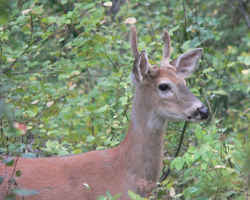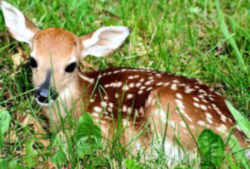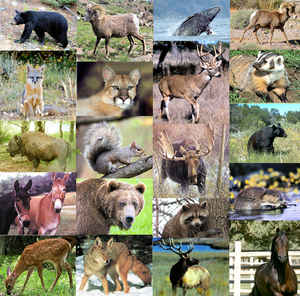Illinois State Animal
White-tailed Deer

(Odocoileus virginianus)
Adopted in 1982.
State Animal - White-tailed Deer: The state animal was selected by a vote of Illinois schoolchildren in 1980. The white-tailed deer, (Odocoileus virginianus,) was selected from candidates nominated by the General Assembly and the Illinois State Museum. A bill was signed into law by Gov. James R. Thompson, effective Jan. 1, 1982. The deer, native to North America, has a gray coat that turns reddish brown in summer and an eye-catching tail that is bright white on the underside.
2005-2006 Illinois Blue BookToday the white-tailed deer is a familiar sight in most of Illinois. This has not always been the case; deer almost went extinct in the state. During the early 1800s deer were abundant throughout the state. Market hunting and drastic changes in land use during the 1800s led to the elimination of the native deer herds by about the beginning of the 1900s. Apparently, the last native deer was sighted in 1912 in southern Illinois.
States that have named the White-tailed deer, (Odocoileus virginianus,) as their official state mammal and/or animal:
Arkansas | Illinois | Michigan
Mississippi | Nebraska | New Hampshire | Ohio
Oklahoma | Pennsylvania | South Carolina | Wisconsin
Illinois State Animal: White-tailed Deer

In Illinois' early days, Native Americans and Midwestern settlers relied heavily on the white-tailed deer for food and its hide for clothing and shelter. Interestingly enough, because of unregulated hunting in the mid to late 1800s, the white-tailed deer was nearly extirpated, that is, it had just about disappeared from Illinois completely. Years later, the Department of Conservation used careful management techniques and was able to bring the species back to abundance.
The coat of the white-tailed deer is reddish-brown in summer and grayish-brown in winter. The belly, throat and areas around the mouth and nose of the deer are white. The tail, which the deer often raises as a warning for danger, also is white, giving the species its name. Young deer (fawns) less than 6 months old have white spots all over their coats. The average adult female at 1 year old is about 120 pounds while the male yearling weighs about 150 pounds.
White-tailed deer live in forested areas, thickets and even suburban areas. They eat a variety of plants including forest trees & shrubs, orchard trees, acorns, garden plants, soybeans, corn, wheat and rye. Male deer (bucks) grow antlers every spring. At first, antlers are covered with a velvety skin. By early fall this velvet has been rubbed off. After breeding, in December or January, the antlers fall off. The female (doe) gives birth to one to three fawns, usually in June.
Common Names
white-tailed deer; whitetail deer; Columbian white-tailed deer; Key deer; Coues deer; Texas white-tailed deer; sand-hill deer; common deer; jumping deer; flag-tailed deer; banner-tail; long-tailed deer; Virginia white-tailed deer; Virginia deer
Characteristics of the White-tailed Deer
Physical Characteristics
Head and body length is 150 to 200 cm, tail length is 10 to 28 cm, and height at the shoulders is between 80 and 100 cm.
Odocoileus virginianus dorsal coloration differs in shading locally, seasonally, and among subspecies; however in general it is grayer in the winter and redder in the summer. White fur is located in a band behind the nose, in circles around the eyes, inside the ears, over the chin and throat, on the upper insides of the legs and beneath the tail. Whitetail deer have scent glands between the two parts of the hoof on all four feet, metatarsal glands on the outside of each hind leg, and a larger tarsal gland on the inside of each hind leg at the hock. Scent from these glands is used for intra-species communication and secretions become especially strong during the rutting season. Males possess antlers which are shed from January to March and grow out again in April or May, losing their velvet in August or September. At birth, fawns are spotted with white in coloration and weight between 1.5 and 2.5 kg. Their coats become grayish lose their spots by their first winter. Whitetail deer have good eyesight and acute hearing, but depend mainly on their sense of smell to detect danger.
Food Habits
Whitetail deer feed on a variety of vegetation, depending on what is available in their habitat. In eastern forests, buds and twigs of maple, sassafras, poplar, aspen and birch (to name a few) are consumed, as well as many shrubs. In desert areas, plants such as huajillo brush, yucca, prickly pear cactus, comal, ratama and various tough shrubs may be the main components of a whitetail's diet. Conifers are often utilized in winter when other foods are scarce. Whitetail deer are crepuscular, feeding mainly from before dawn until several hours after, and again from late afternoon until dusk.
Reproduction
Most whitetail deer (particularly males) mate in their second year, although some females occasionally mate as young as seven months. Bucks are polygamous although they may form an attachment and stay with a single doe for several days or even weeks until she reaches oestrus. Does are seasonally polyoestrous and usually come into heat in November for a short twenty-four hour period. If a doe is not mated, a second oestrus occurs approximately 28 days later. Mating occurs from October to December and gestation is approximately 6 and a half months. In her first year of breeding, a female generally has one fawn, but 2 per litter (occasionally 3 or 4) are born in subsequent years. Fawns are able to walk at birth and nibble on vegetation only a few days later. They are weaned at approximately six weeks. Life span in the wild is 10 years, but whitetail deer have lived up to 20 years in captivity.
Behavior
Whitetail deer are the most nervous and shy of our deer. They wave their tails characteristically from side to side when they are startled and fleeing. They are extremely agile and may bound at speeds of up to 30 miles per hour through tangled terrain in a forest. Whitetail deer are also good swimmers and often enter large streams and lakes to escape predators or insects or to visit islands. Their home ranges are generally small, often a square kilometer or less. Whitetail deer do not migrate to a winter range but yard up in their own territories during heavy snow. They are notorious for continually using the same pathways when foraging, but will not bed down during the day in areas that they have used previously.
Whitetail deer are generally considered solitary, especially in summer. The basic social unit is a female and her fawns, although does have been observed to graze together in herds of up to hundreds of individuals. Females generally follow their mothers for about two years, but males leave the group within the first year. Bucks may form transient groups of 2-4 in the summer, but these disband prior to the mating season. Males begin rutting as early as September, and at this point become entirely preoccupied with obtaining mating. They do not guard harems (as with elk) but rather fight each other individually, clashing antlers to gain access to a particular female.
Whitetail does are painstakingly careful to keep their offspring hidden from predators. When foraging, females leave their offspring in dense vegetation for about four hours at a time. While waiting for the female to return, fawns lay flat on the ground with their necks outstretched, well camouflaged against the forest floor. Fawns withhold their feces and urine until the mother arrives, at which point she ingests whatever the fawn voids to deny predators any sign of the fawn.
Whitetail deer are not especially vocal, although young fawns bleat on occasion. Injured deer utter a startlingly loud "blatt" or bawl. Whistles or snorts of disturbed whitetails are the most commonly heard sounds.
Habitat
Whitetail deer are able to survive in a variety of terrestrial habitats, from the big woods of northern Maine to the deep saw grass and hammock swamps of Florida. They also inhabit farmlands, brushy areas and such desolate areas of the west such as the cactus and thorn brush deserts of southern Texas and Mexico. Ideal whitetail deer habitat would contain dense thickets (in which to hide and move about) and edges (which furnish food).
There are 16 subspecies of white-tailed deer in North America. Subspecies are distinguished by geographic location, body size, coloration, antler growth, and physiological, biochemical, and behavioral differences .
Scientific name
The genus name Odocoileus is from the Greek words odon (tooth) and koilos (hollow) or "hollow tooth," in reference to the depressions in the crown of the molar teeth. The Latinized species name virginianus (of Virginia) refers to the state from which the species was first collected and described.
Illinois Law
The law designating the white-tailed deer as the official Illinois state animal is found in the Illinois Compiled Statutes, Government, Chapter 5, Section 460/45.
GOVERNMENT
CHAPTER 5 - GENERAL PROVISIONS.
(5 ILCS 460/) State Designations Act.
(5 ILCS 460/45)
Sec. 45. State animal. The animal Odocoileus virginianus, commonly known as the "white-tailed deer", is designated the official State
animal of the State of Illinois.
(Source: P.A. 87-273.)
Taxonomic Hierarchy: White-tailed Deer
Kingdom: Animalia
Phylum: Chordata
Class: Mammalia
Order: Artiodactyla
Family: Cervidae
Subfamily: Capreolinae
Genus: Odocoileus
Species: O. virginianus








